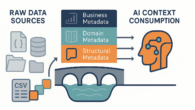The Role of Interoperability in Data Mesh Architecture
What is data mesh? — I tried to cover basic introduction to data mesh principles and architecture in my previous blog.

In the ever-evolving landscape of data management, the concept of a data mesh has emerged as a revolutionary model, decentralizing data ownership and processing. However, the success of such a decentralized system hinges on a critical factor: interoperability. This article delves into the essence of interoperability in data mesh architectures, exploring its pivotal role and impact.
what is interpretability? — Interoperability in data architecture refers to the ability of different data systems, processes, and applications to connect, communicate, and work together effectively within an organization or across different organizations. This concept is crucial in modern data architecture for several key reasons:
1. Seamless Data Exchange: Interoperability allows for the smooth exchange of data between different systems and platforms. This is particularly important in environments where data is stored in various formats and locations.
2. Enhanced Collaboration: By ensuring that systems can interact with each other, interoperability facilitates collaboration between different departments, organizations, and technology ecosystems.
3. Standardization: It often involves the use of common standards and protocols, which helps in standardizing data formats, communication methods, and procedures across different systems.
4. Increased Efficiency: With interoperable systems, data can be more easily accessed and used by different parts of an organization, leading to increased efficiency and productivity.
5. Scalability and Flexibility: Interoperable architectures are generally more scalable and flexible, allowing for the integration of new technologies and systems as they emerge.
6. Data Integrity and Quality: When systems are interoperable, there’s less risk of data loss or errors during transfers between systems, leading to improved data integrity and quality.
7. Decision Making and Analytics: Interoperability enhances the ability to aggregate and analyze data from various sources, leading to better-informed decision-making and more robust analytics.
Interoperability in data architecture is about creating a cohesive environment where different data systems and processes can work together efficiently and effectively, enabling organizations to leverage their data assets to their fullest potential.
The Role of Interoperability in Data Mesh
Interoperability, in the context of a data mesh, refers to the ability of independently developed and maintained domain data products to effectively communicate, exchange data, and use the data that has been exchanged. Here’s why interoperability is non-negotiable in a data mesh architecture:
Seamless Data Exchange Across Domains: In a data mesh, data is distributed across various domains, each managed by a cross-functional team. Interoperability ensures that these disparate data products can interact seamlessly, allowing data to flow smoothly across domains without bottlenecks.
Ensuring Data Consistency and Quality: Interoperable systems in a data mesh help maintain data consistency and quality. They enable standardized data formats and common protocols, which are vital for ensuring that data remains accurate and reliable as it moves across different domains.
Facilitating Collaborative Data Governance: Data governance is a collective responsibility in a data mesh. Interoperability supports this by enabling a unified view of data across different domains, making it easier to implement and enforce governance policies effectively.
Enhancing Scalability and Flexibility: Interoperability makes a data mesh architecture scalable and adaptable. As business needs evolve, new data domains can be added or existing ones modified with minimal disruption, thanks to the interoperable nature of the system.
Challenges and Strategies for Achieving Interoperability
Achieving interoperability in a data mesh is not without its challenges. These include aligning different data models, dealing with legacy systems, and ensuring data security across domains. To address these, organizations must adopt strategies like using standardized data formats, employing robust API strategies, and implementing comprehensive security protocols.

Achieving interoperability within a data mesh, or any complex data architecture, presents several challenges. However, by employing strategic approaches, these challenges can be effectively managed. Let’s delve into some of the key challenges and explore strategies to overcome them.
Challenges of Achieving Interoperability
1. Diverse Data Formats and Standards: In a data mesh, data originates from various domains, each potentially using different formats and standards. This diversity can hinder seamless data integration and usage.
2. Legacy Systems Integration: Incorporating legacy systems, which may not be designed for modern interoperable environments, can be a significant challenge.
3. Data Security and Privacy: Ensuring data security and privacy compliance across different systems and domains is complex, especially when dealing with sensitive or regulated data.
4. System and Domain Autonomy: Balancing the autonomy of different data domains with the need for standardized interoperability can be difficult.
5. Scalability Issues: As the data mesh grows, ensuring that interoperability scales effectively to accommodate new domains and increased data volumes is challenging.
6. Technical and Organizational Silos: Breaking down silos and fostering a culture of collaboration across different teams and technical environments is a non-trivial task.
Strategies for Achieving Interoperability
1. Standardization of Data Formats and Protocols: Adopting standardized data formats (like parquet, avro and JSON, XML) and communication protocols (like RESTful APIs, gRPC) across domains ensures consistent data exchange. Let’s also agree, you can not support everything in one common platform. It is indeed important to draw thin boundaries while designing your architecture.
2. API-First Approach: Implementing an API-first approach can facilitate smooth communication between different systems, providing a flexible and scalable way to share data. SQL-Federation is very essential part of data mesh but when it comes to collaboration between data platforms and backend services, standardizing API is key to success.
3. Data Governance Policies: Establishing robust data governance policies helps maintain data quality and security across the mesh, ensuring compliance with privacy regulations.
4. Use of Middleware and Integration Tools: Leveraging middleware and data integration tools can bridge the gap between different systems and data formats, simplifying the integration of legacy systems.
5. Containerization and Microservices: Adopting containerization and microservices can enhance scalability and make it easier to manage different components of the data mesh.
6. Cross-Domain Collaboration: Fostering a culture of collaboration and communication across different domains ensures that interoperability is not just a technical initiative but a part of the organizational ethos.
7. Continuous Monitoring and Improvement: Regularly monitoring interoperability effectiveness and being open to iterative improvements can help in addressing new challenges as they arise.
8. Training and Education: Providing adequate training and resources to teams helps in understanding and implementing interoperability best practices effectively.
By addressing these challenges with thoughtful strategies, organizations can achieve a high degree of interoperability in their data mesh architecture, leading to more efficient, agile, and collaborative data management practices.
Conclusion
The essence of interoperability in a data mesh architecture cannot be overstated. It’s the glue that binds the various data domains together, ensuring that the decentralized approach of data mesh does not lead to data silos or inefficiencies. By prioritizing interoperability, organizations can fully leverage the benefits of a data mesh, turning their data into a powerful, collaborative asset that drives innovation and growth.








Leave a Reply